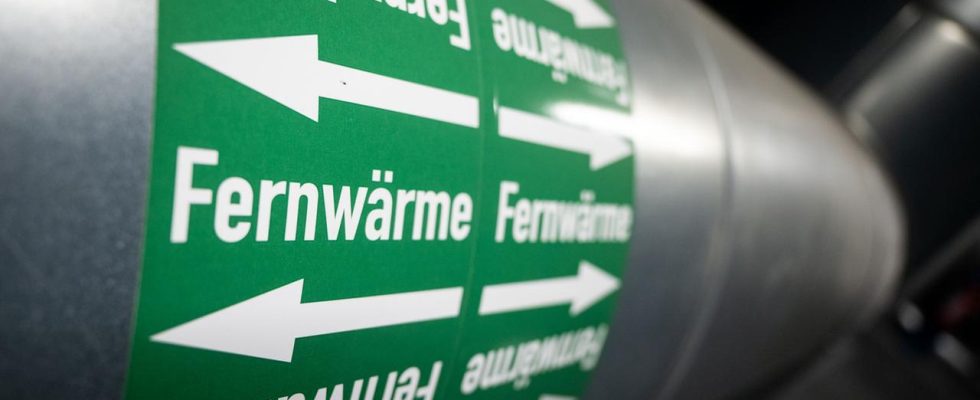With municipal heat planning, the federal government wants to get an important building block for climate-friendly heating off the ground. This is no small matter for the municipalities.
The winding water slide of the forest swimming pool in Eisenberg in the Palatinate is 83 meters long. The outdoor pool in the middle of the forest attracts many schoolchildren every day these days, who enjoy their summer holidays between the slide, the red and white fries and the 10-metre diving board.
The pool is operated by the local energy supplier. And he is currently in the process of developing a concept for how the bathroom could be converted to alternative energy use in the long term. A small building block on the way to municipal heating planning – a start.
The Rhineland-Palatinate municipality of Eisenberg has a little over 13,000 inhabitants. It must submit its plans for a heat transition to the federal government by 2028 at the latest. Cities with more than 100,000 inhabitants have a little less time, namely until 2026, according to the draft law of the Federal Ministry for Housing, Urban Development and Building.
exact general conditions still unclear
Eisenberg’s mayor Bernd Frey (SPD) wants to commission a study that will first provide an inventory and answer the question of how much heat private households and public buildings in the community consume. Eisenberg will receive 88,000 euros from the federal government for this study. The municipality’s application for participation in the federal funding program “Creation of a municipal heating plan” has just been approved, explains Frey.
The mayor is now eagerly awaiting what the cabinet in Berlin will decide today. Because it depends on how the municipality continues on its “transformation path”: “We have to know exactly what the framework conditions for municipal heating planning look like in order to be able to take more concrete steps.”
A new development area with 45 building sites is currently being planned in Eisenberg, which is to be heated with so-called cold local heating, an environmentally friendly and fuel-free heat supply.
A spokesman for Klara Gewitz (SPD), a spokesman for the Ministry of Building, explains that the cities and communities will play a decisive role in the success of the heat transition. The relevant course setting would not only have to be made at federal and state level, but above all locally. Which infrastructures are necessary for this must be discussed with the citizens and companies concerned and then implemented.
Share of renewable energies at 18 percent
The goal of the federal government is to convert the heating networks completely to the use of renewable energies by 2045. According to the ministry, the share of renewable energies for space heating in private households is currently only around 18 percent. Around eight percent of households are currently supplied with district heating; Here, too, the share of renewable energies is only about 20 percent.
According to the Federal Ministry, the goals of the Federal Climate Protection Act could not be achieved without a significant reduction in heat consumption and at the same time a significantly accelerated expansion of renewable energies.
Also relevant for private homeowners
Municipal heating plans are also extremely interesting for homeowners. After all, how the owner of a property behaves depends on the plans in their town or city: homeowners who have the prospect of being connected to a district heating network do not have to convert their heat supply to renewable energies. And could possibly save yourself the installation of an expensive electric heat pump. This regulation was later included in the law after the criticism of the new Building Energy Act (GEG).
criticism of the schedule
Lamia Messari-Becker is Professor of Building Technology and Building Physics at the University of Siegen. The civil engineer is an expert for the Bundestag and formulates criticism: “I do not think it is expedient at all not to pass the Heat Planning Act at the same time as the Building Energy Act.”
There are some contradictions between the two laws that are a hindrance to a necessary heat transition in buildings. Messari-Becker calls on the federal government to better harmonize both laws.
Large personnel effort
Messari-Becker sees another problem in the fact that there is a lack of staff in the responsible authorities. It is urgently necessary to form state agencies that coordinate the heat planning in the individual municipalities in each state. There are currently no plans for this, and knowledge transfer is extremely important.
For example, if a municipality found a good solution to a problem, everyone could benefit from it. “It’s about not every municipality planning on its own, but in regional cooperation,” says the engineer.
Still a long way
So far, the city of Koblenz in the north of Rhineland-Palatinate has also been planning alone. After all: Here, too, the managing director of the public utility company, Lars Hörnig, set the first course. The city’s application for funding has already been approved by the Rhineland-Palatinate Energy Agency. Planning offices can now apply for the contract in the coming months.
It is high time that the plans became more concrete, says Lars Hörning: “There is a great deal of uncertainty among the population and companies, and it is therefore good that we can now get started with the participation of the stakeholders.”

